Apr 13, 2025
Apr 13, 2025
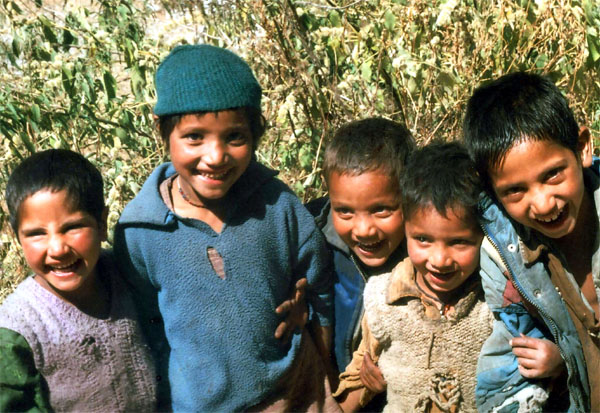 In the October of 2006, during the Puja vacation, my younger brother Ujjal, my colleague Kamal and I went to Har - Ki - Doon trek. The region interests me very much, because I read that it is one of the few places in India where Duryodhana and Karna are worshipped as God. Har-Ki-Doon falls within the Govind Pashu vihar sanctuary. Haridwar to Sankri (6500 ft) is 240 KM. Our trek starts from Sankri. We spend the night at the bungalow of Garhwal Mandal Vikash Nigam. We hire a guide-cum-porter. He is Vikram, a nice looking lad of nineteen. He reads in college and does this job part-time. The present rate of a guide is Rs. 250 per day. Sankri to Taluka is 12 Km Trek. As we near Taluka, these children greet us with ‘namaste’ and ask ‘meethai.’ We oblige them with sweets, and they oblige us with sweet smiles!
In the October of 2006, during the Puja vacation, my younger brother Ujjal, my colleague Kamal and I went to Har - Ki - Doon trek. The region interests me very much, because I read that it is one of the few places in India where Duryodhana and Karna are worshipped as God. Har-Ki-Doon falls within the Govind Pashu vihar sanctuary. Haridwar to Sankri (6500 ft) is 240 KM. Our trek starts from Sankri. We spend the night at the bungalow of Garhwal Mandal Vikash Nigam. We hire a guide-cum-porter. He is Vikram, a nice looking lad of nineteen. He reads in college and does this job part-time. The present rate of a guide is Rs. 250 per day. Sankri to Taluka is 12 Km Trek. As we near Taluka, these children greet us with ‘namaste’ and ask ‘meethai.’ We oblige them with sweets, and they oblige us with sweet smiles!
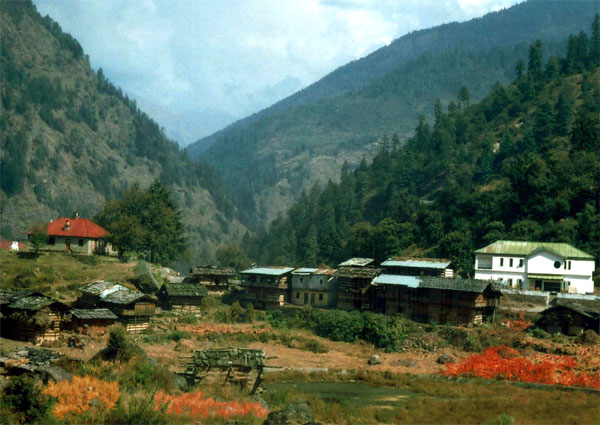 Sankri to Taluka (1900 Mtrs) is an easy trek. 3 yrs back jeeps could ply this route, but a massive landslide has done away with that luxury. No sign of repair work.
Sankri to Taluka (1900 Mtrs) is an easy trek. 3 yrs back jeeps could ply this route, but a massive landslide has done away with that luxury. No sign of repair work.
Taluka is a very colorful hamlet. This is a view of Taluka on our first sighting. The red-roofed building at the left is the Forest Rest House. The green-roofed white one is the GMVN Bungalow.
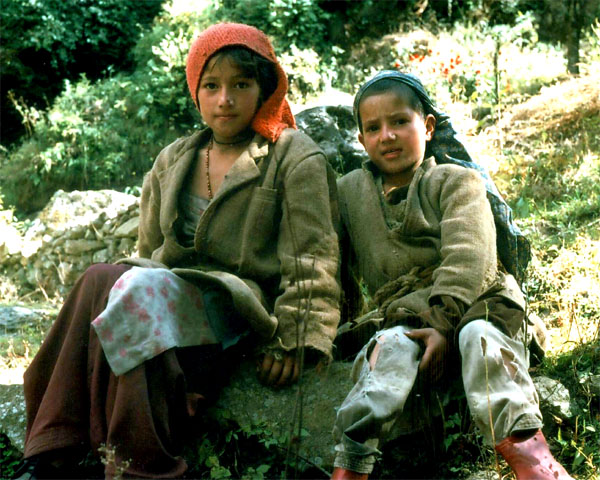 These two fairies welcome us as we approach. Another spell of sweet-sweet exchange. We are refreshed. We stay at the Forest Rest house. We do not have any advance booking. The ever-smiling chowkider manages it all.
These two fairies welcome us as we approach. Another spell of sweet-sweet exchange. We are refreshed. We stay at the Forest Rest house. We do not have any advance booking. The ever-smiling chowkider manages it all.
This view of the Har-ki-doon Ganga is from the lawn of the Forest Rest house. At night we have ‘Khichdi’ and omelet at the local dhaba with local people.
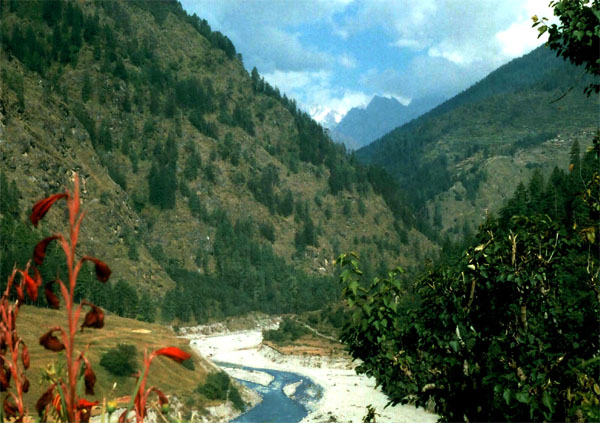 We gather information about the route and the local myths as we gobble the smoking Amrita. We are warned by some down-stream trekkers that beyond Taluka they charge Rs.10 an egg! We decide to take our ration for the next few days from here. Food is scarce and very costly up there. Better to be equipped with eggs!
We gather information about the route and the local myths as we gobble the smoking Amrita. We are warned by some down-stream trekkers that beyond Taluka they charge Rs.10 an egg! We decide to take our ration for the next few days from here. Food is scarce and very costly up there. Better to be equipped with eggs!
Early morning we start our trek from Taluka. Todays’ destination is Seema at a distance of 14 KM.
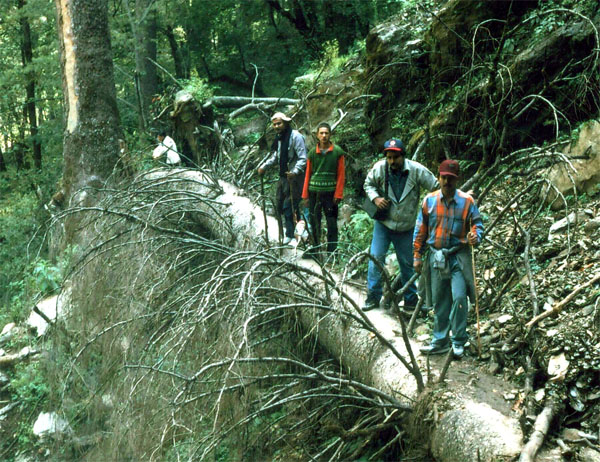 As we take a short-cut to Seema through dense forest, the trek becomes adventurous. The dense forests of a variety of conifer trees are rich in wildlife. Our trail goes along the Har-ki-doon Ganga. Huge lizards and Langurs are all that we can sight at this time. This image is of a unique ‘Tree-bridge’ the like of which I have never met before. There is a deep gorge down below. As we cross, the river congratulates us with tumultuous roar.
As we take a short-cut to Seema through dense forest, the trek becomes adventurous. The dense forests of a variety of conifer trees are rich in wildlife. Our trail goes along the Har-ki-doon Ganga. Huge lizards and Langurs are all that we can sight at this time. This image is of a unique ‘Tree-bridge’ the like of which I have never met before. There is a deep gorge down below. As we cross, the river congratulates us with tumultuous roar.
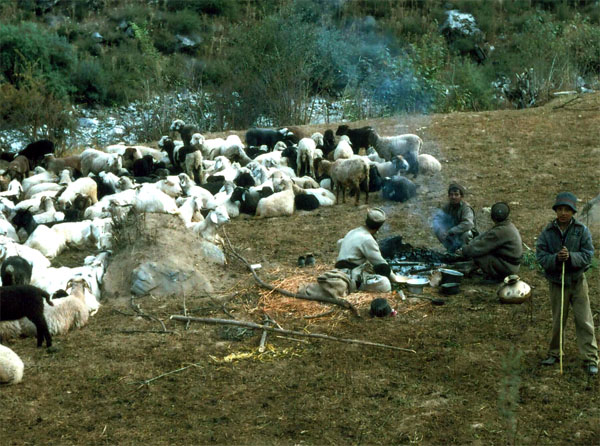 We meet these shepherds, the last specimen of our pastoral ancestors. As we mix with them, we find their life is not as idyllic as romantic poets would have us believe.
We meet these shepherds, the last specimen of our pastoral ancestors. As we mix with them, we find their life is not as idyllic as romantic poets would have us believe.
With the advent of the long winter months they are now going down to their villages with their cattle treasure. Fall April, and they will come up again to the ‘Bugiyals’ (green pastures).
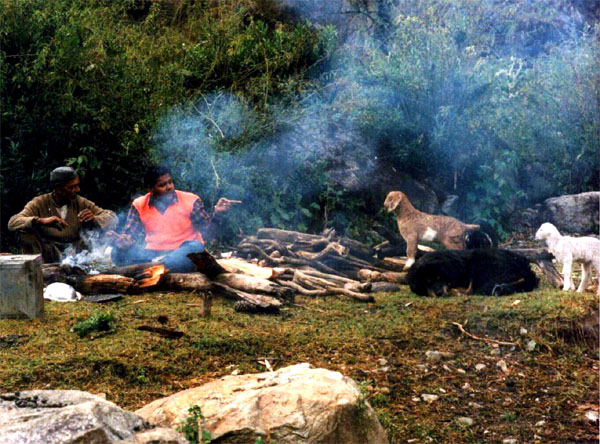 The Shepherd-Chacha introduces us to the huge dark loyal thing, squirming now in a siesta. Our chatters wake it up. Soon we find the difference between appearance and reality. It is very friendly to us. It wags its tail violently.
The Shepherd-Chacha introduces us to the huge dark loyal thing, squirming now in a siesta. Our chatters wake it up. Soon we find the difference between appearance and reality. It is very friendly to us. It wags its tail violently.
One of us must have been Yudhishthira in our previous incarnation, we are confirmed!
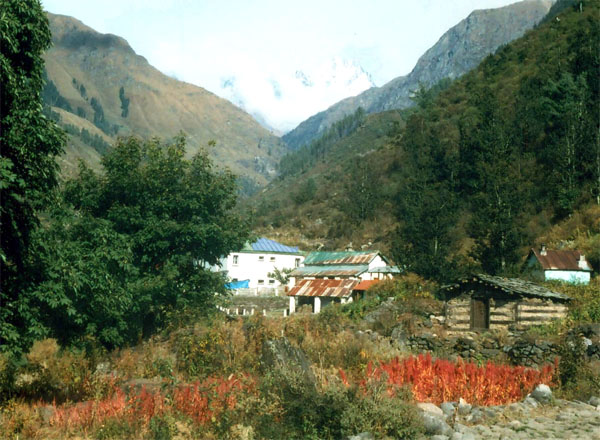 The trek from Talukar to Osla is through dense forests of chestnuts, walnuts, willows and chinars. We reach Seema village (9500 ft) after a trek of 6 hrs. Actually it is a halt, not much of a village. The Forest Rest house, GMVN Bungalow and a few ‘Chhotis’ and ‘dhabas’ are all that are there. Seema’s twin sister is Osla on the other side of Har-ki-doon Ganga. It is a village of about 120 families.
The trek from Talukar to Osla is through dense forests of chestnuts, walnuts, willows and chinars. We reach Seema village (9500 ft) after a trek of 6 hrs. Actually it is a halt, not much of a village. The Forest Rest house, GMVN Bungalow and a few ‘Chhotis’ and ‘dhabas’ are all that are there. Seema’s twin sister is Osla on the other side of Har-ki-doon Ganga. It is a village of about 120 families.
The present pradhan of Osla-Seema is Baru Singh Rana. Osla-Seema is in fact a Rana village. It is from Seema that climbers go to the base camp of Black Peak (Kala Nag, as it is known locally).
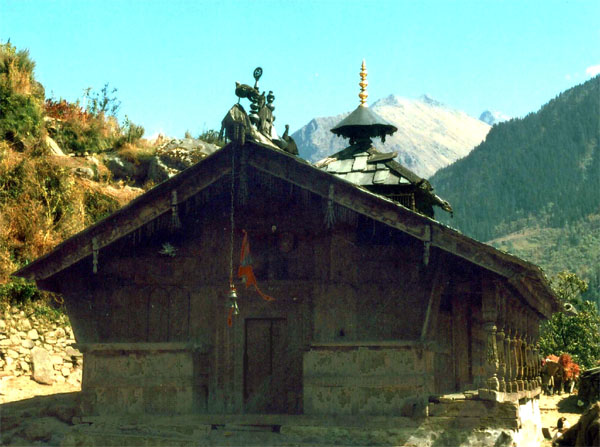
This is the famous Duryodhana temple of Osla village. It is a 2 KM trek from Seema. As we approach Osla, our guide, a resident of this village frustrates us. He says it is not Duryodhana but Someshwarji’s temple. We are confused. Vikrama tells us once upon a time it was mistakenly thought to be Duryodhana, but actually it is Someshwar. He also tells us people will feel offended if we insist on calling it Duryodhana, because Duryodhana was a ‘Rakshasa.’ Our interest grows. We decide to speak to some elderly people of Osla to get the actual information. What we gather is indeed unique and merits serious anthropological studies. In 1974 the elderly people of all the 22 villages in this region decided to change the name of their local deity from Duryodhana to Someshwar. A born looser Duryodhana! No doubt. His last kingdom is finally gone.
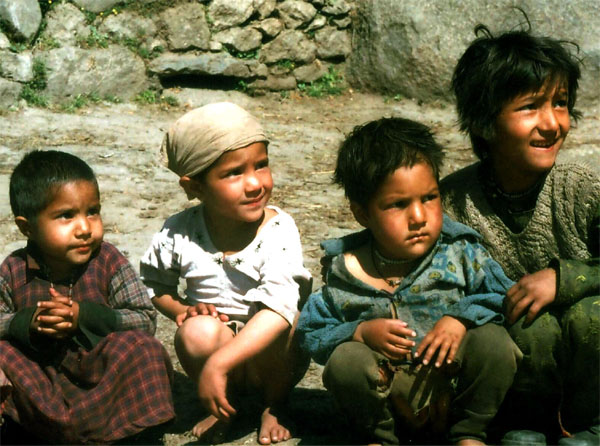 Duryodhana or Someshwar, here are the real Gods. The children do not care that their elders have relinquished their own culture. Once, the people of this region boasted of carrying Duryodhana’s blood in their veins. As they mixed with plain-land people they became uncomfortable with their past.
Duryodhana or Someshwar, here are the real Gods. The children do not care that their elders have relinquished their own culture. Once, the people of this region boasted of carrying Duryodhana’s blood in their veins. As they mixed with plain-land people they became uncomfortable with their past.
The village elders decided that there would be no more goat-sacrifices to Duryodhana. It was Someshwar after all!
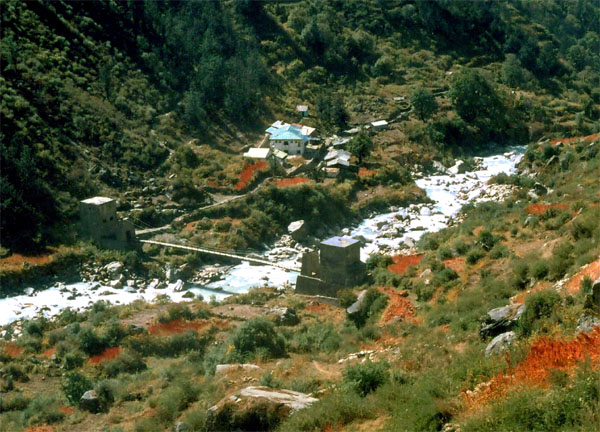 The introduction of solar electricity brought T.V. B.R.Chopra’s Mahabharata drove the final nail into Duryodhana’s coffin. Now the people are fain to deny their past. Fear of cultural isolation! Lord Shiva smiles at the unexpected increase of his followers, and so do these children at the unexpected increase of their toffee stocks.
The introduction of solar electricity brought T.V. B.R.Chopra’s Mahabharata drove the final nail into Duryodhana’s coffin. Now the people are fain to deny their past. Fear of cultural isolation! Lord Shiva smiles at the unexpected increase of his followers, and so do these children at the unexpected increase of their toffee stocks.
Leaving behind Seema, we start our final trek of 12 KM to Har-Ki Doon. The hanging bridge and the Forest Rest house and GMVN Bungalow can be seen down there. There is a steep ascent at the beginning. Then life passes through ups and downs.
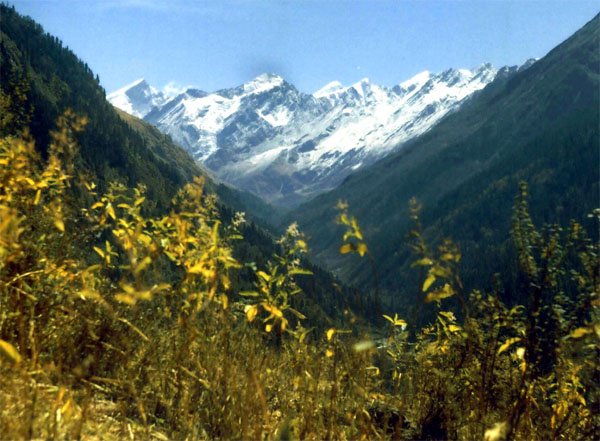
As we trek, the mighty Kalanaga peak (6387 m) stands before us. No words. Only some rapt moments! And then only sounds of clicks.
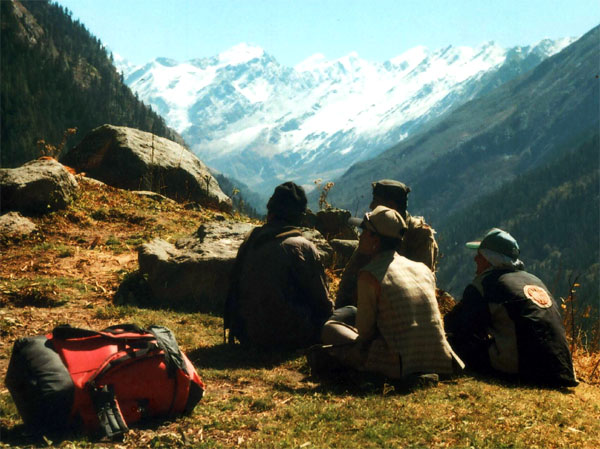 Our guide and some shepherds take rest, have chat and offer prayers to Someshwar. Our tired rucksack takes a nap. We utilise the time gossiping with locals. We get very interesting information. Duryodhana to Someshwar transformation took place in 1974, the year the old temple was renovated. The golden crown of erstwhile Duryodhana was also changed. At present the deity stays at Osla from mid-August to mid-October. The Deity’s tour schedule through the villages in ‘Doli’ is as follows – Osla – Vitari – Kashla – Leowari – Jakul – Paon – Kotgaon – Shankri – Datmer – Gangar – Osla – Dara – Shaonri – Sharturi – Sunkundi – Sirgaon – Jakul – Osla. This has been going on since ages.
Our guide and some shepherds take rest, have chat and offer prayers to Someshwar. Our tired rucksack takes a nap. We utilise the time gossiping with locals. We get very interesting information. Duryodhana to Someshwar transformation took place in 1974, the year the old temple was renovated. The golden crown of erstwhile Duryodhana was also changed. At present the deity stays at Osla from mid-August to mid-October. The Deity’s tour schedule through the villages in ‘Doli’ is as follows – Osla – Vitari – Kashla – Leowari – Jakul – Paon – Kotgaon – Shankri – Datmer – Gangar – Osla – Dara – Shaonri – Sharturi – Sunkundi – Sirgaon – Jakul – Osla. This has been going on since ages.
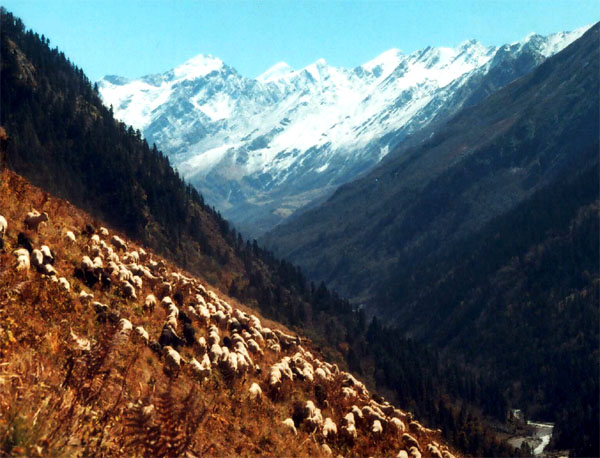 The present chief priest is Chain Singh of Jakul village. It is a unique ritual that the priest has to prepare his own ‘Roti’.
The present chief priest is Chain Singh of Jakul village. It is a unique ritual that the priest has to prepare his own ‘Roti’.
A flock of sheep, like an endless stream, flows past us leaping and bouncing along the slopes. The shepherds make peculiar sounds to keep them together, as the watchful shepherd dogs are very busy in their vigilance. They scold the straying sheep. No mischief, be serious!
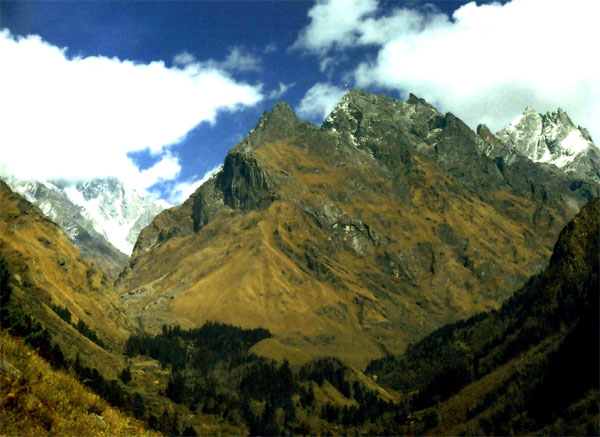
As our trail turns left, we lose sight of Kalanag peak, only to be compensated with new splendors. So long we have been trekking through terraced mountain fields and lush green grassy land. Farming of Rice and Rajma are most common. Now we enter conifer forests.
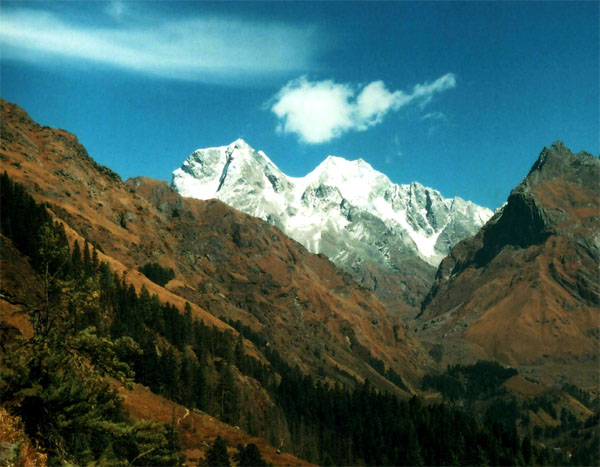
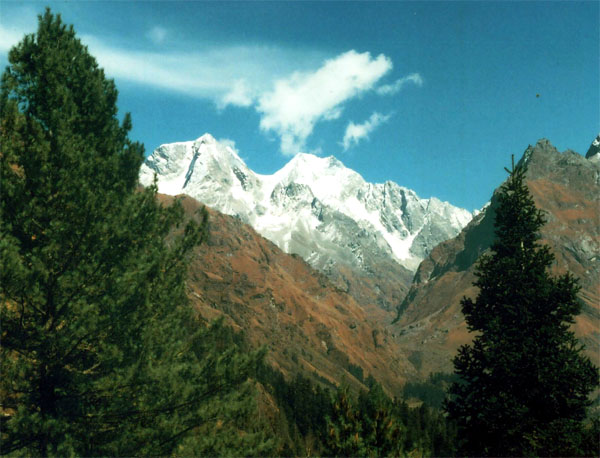
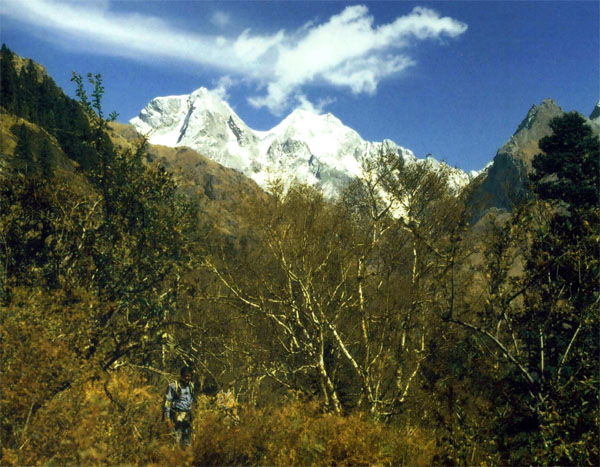
This is Ata Peak. We trek along mountain slopes of ridges. The trees are so green and the sky is so blue! We have to pass now through a dense forest.
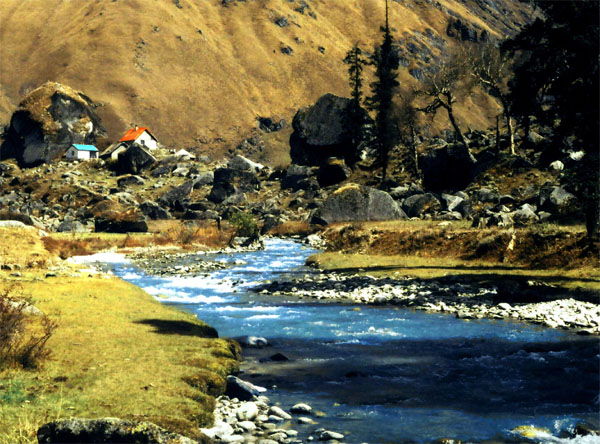
Finally we reach Har-ki-doon valley after a trek of 6 hrs. The Har-ki-doon Ganga flows on level surface. We are surrounded by peaks. We sit by the river and refresh. No hurry. The Forest Rest house can be seen over there. Just another lazy walk of half a Kilometre.
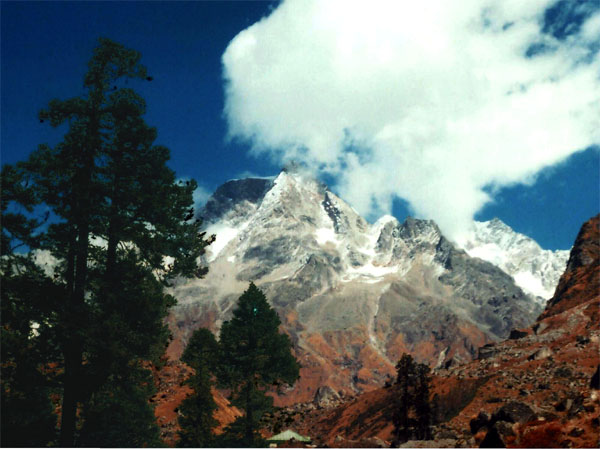
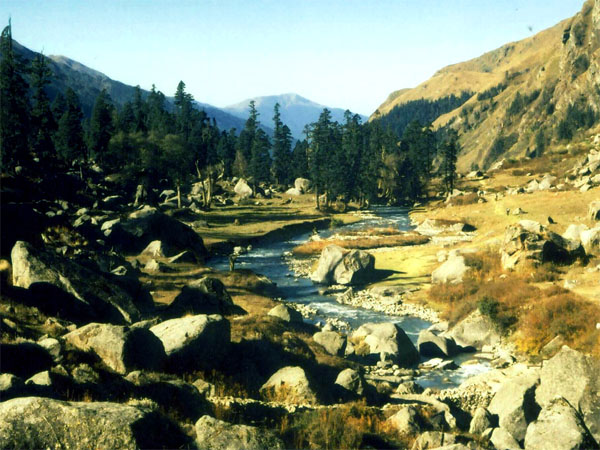
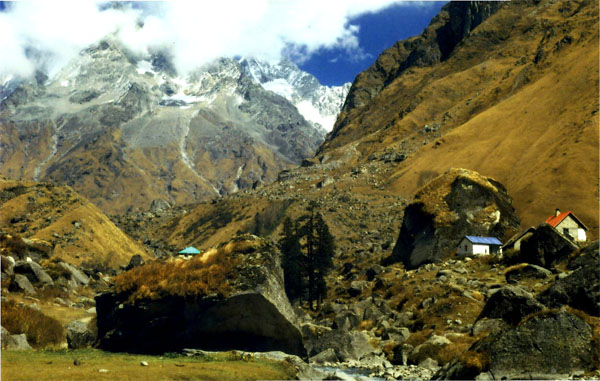
A view of the northern side (Left Image) of the Har-ki-doon valley. Another shot of the valley and the Ganga (Middle Image) from Forest Rest house. That is the south-west side, (Right Image) through which we have entered the valley.
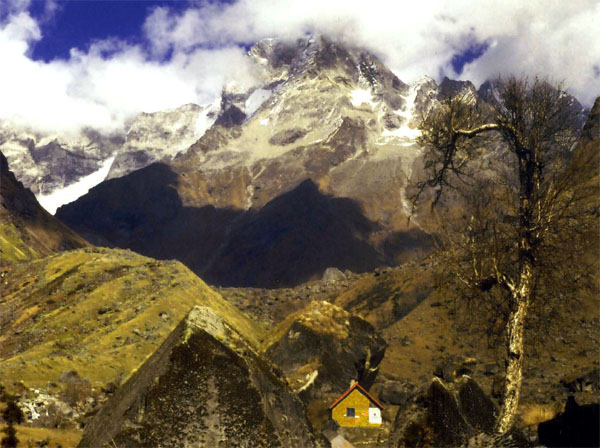
This is the north view of the place. The Ata Peak is clouded. The red-roofed one at the right is the Forest Rest house, and the sky-blue roof at the mid-left is the GMVN.
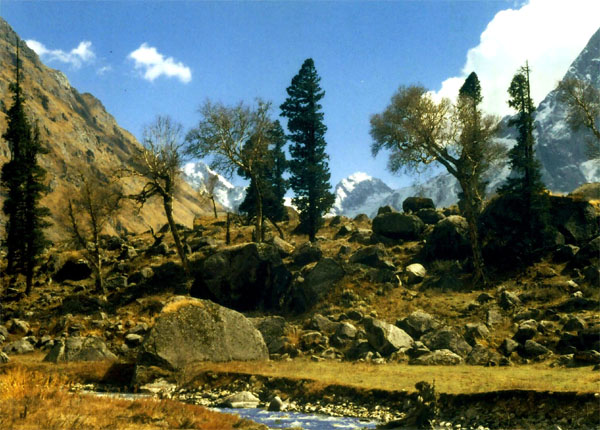
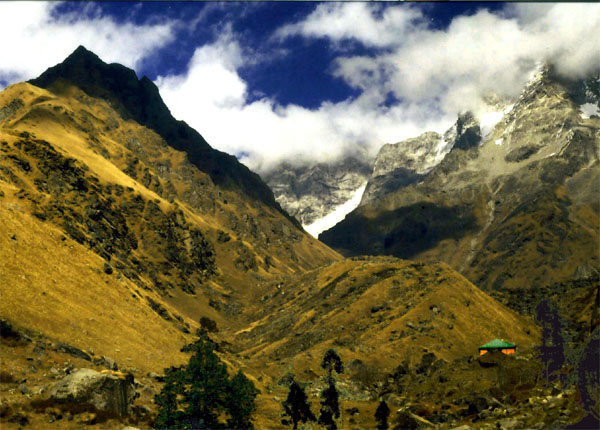
We stroll relaxed along the Har-ki-doon Gad. Parts of the Swargarohini range are visible through the trees. The play of cloud and sun with the mighty peaks.
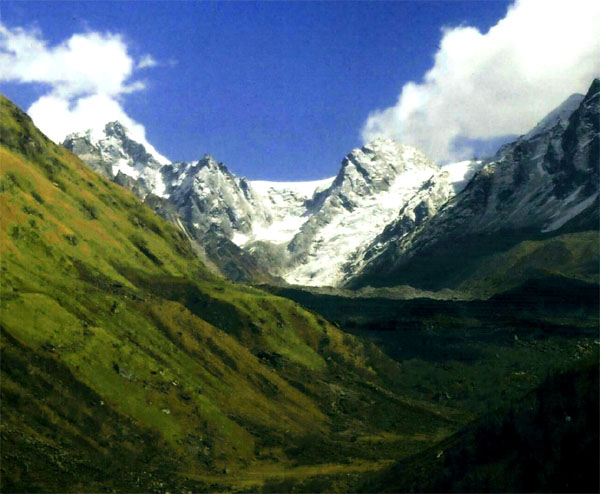 The Yamadwar Glacier or Jaundhar Glacier is over there at a distance of 6 KMs from the valley.
The Yamadwar Glacier or Jaundhar Glacier is over there at a distance of 6 KMs from the valley.
The trekking route trails along the slopes and then along the river bank. The glacier is entirely covered with moraine and dust.
We have read that the snout of the glacier was just 2 KM from the rest house a few decades back. Global warming is taking its toll. The entire glacier might vanish over the next decade.
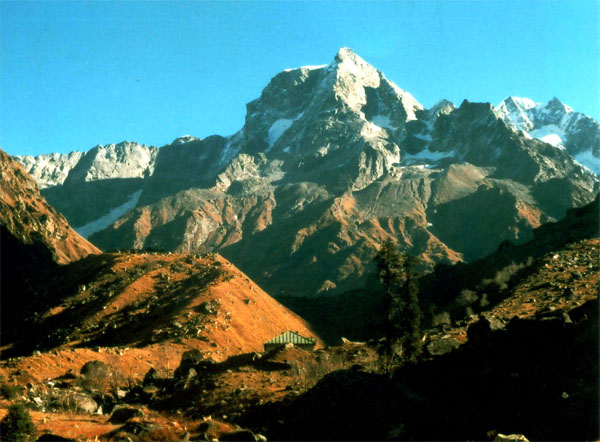
This is Ata Peak with the green-roofed GMVN Bungalow perched on its lap.
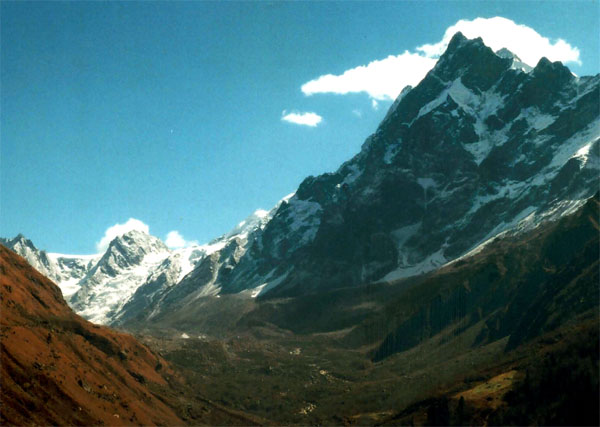 This is a view of the Swargarohini Peak and Yamadwar Glacier at its feet.
This is a view of the Swargarohini Peak and Yamadwar Glacier at its feet.
Legend has it that the Pandavas went along this route in their last journey. Yudhishthira went to the Heavens in his physical body from this mountain. According to another legend, the Pandavas approached the Swargarohini via Badrinath. That is possible given the fact that glacial structures were different thousands of years back.
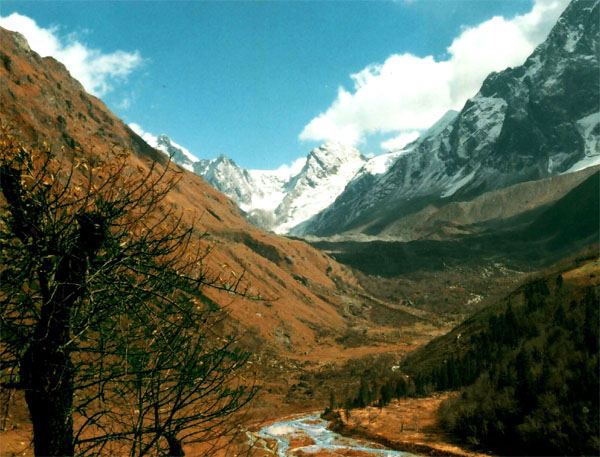 This is another view of the Yamadwar Glacier and the Yamadwar Gad (river) as viewed from the Rest house lawn.
This is another view of the Yamadwar Glacier and the Yamadwar Gad (river) as viewed from the Rest house lawn.
This river mixes with Marinda and Ata Gad at Har-ki-doon.
Together they form the Har-ki-doon Ganga.
Today we go to Morinda Tal, a trek of 3 KM. It is a lake from where Morinda Gad originates. At the beginning of our trek, the Ata peak salutes us in its morning splendor.
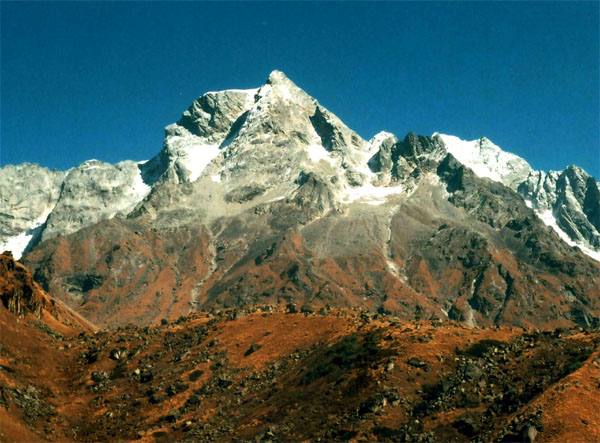
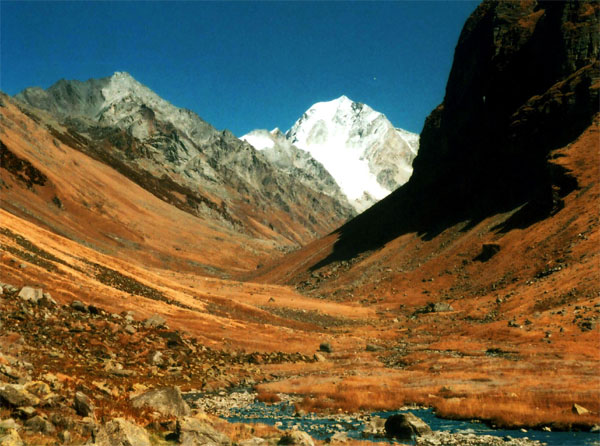 The trek to Morinda Tal is across rocky terrain. There is no tree around. We are now above tree-line. The Morinda Gad is our constant companion.
The trek to Morinda Tal is across rocky terrain. There is no tree around. We are now above tree-line. The Morinda Gad is our constant companion.
We reach the Morinda Tal after one and a half hours trek. Unfortunately for us, there is not much water at this time of the year. Nevertheless, we sit for hours enjoying the celestial sight around. The snow-clad peak far out there calls us for another trek. The trek to Barasu pass is that way.
This is all about our present trek. We return with the promise to come yet again for the Barasu pass trek.
01-Apr-2007
More by : Indrajit Bandyopadhyay

|
i did the trek towards the end of december, 2015. It was snow and just snow everywhere. A really good post on the har ki dun trek... |

|
Hi.... I am Anil Mittal this side. An avid traveler and trekker.... Age 54. I live in Dehradun. I am planning a trek to Har ki dun in June. Dates are flexible with me. I have Bullets classic and have tent and sleeping bags. I intend to go on bike from Dehradun to Taluka. 8 days trek from Dehradun to Dehradun. Looking for a company to enjoy the trek and also to share cost app. Rs 5000/- per person. If interested pl call me on my mobile 9639931833. I can also pick you up from Dehradun Rly stn or bus stand. |

|
Hi , O am interested to do Har ki Doon Trek, Can you share oen guid information so that he can arrange all things. |

|
hey....me too a trekker...did the Har Ki Dun Trek on New year From 26th Dec 2013 to 2nd Jan 2014 and it was amazing in negative temperature. We were a group of 10 peoples. Before that I did Mantalai lake in Aug 2013 and my next trek is to Nag TIbba. But in my opinion if you really wanna enjoy the real beauty of Har ki Dun.....u shud go in dec or jan.....it was an exhilarating experience to be there in chilling cold. You will love it for sure. |

|
I went Pindari twice - 1999 and 2007 - first time in October and second time in May. In the second time there was much snow. I am afraid you cannot do it in February. I have recently posted Toli Bugiyal Trek - some part from Sagar to Panar is common with your plan to Rudranath - here it is - See Toli Bugiyal Trek http://www.boloji.com/index.cfm?md=Content&sd=Articles&ArticleID=11702 Regards Indrajit |

|
O.K.This is already added in my preference list. will go according to season. I have a plan to go for a vacation in the coming February. I also planned for a relaxed tour to Kumaun. Can you suggest for Pindari that time? Post your latest expedition early and if possible please give mail to inform me so that I also can have the glimpse. I have seen the photos from one of my friend, those were splendid. Hope you also enjoyed a lot. |

|
I don't think so...probablity of snow very high. The seasons are now late for at least one month. Previously I would visit in September and find clear weather. Last two years I found heavy rainfall. This year I went to Kedar Kantha peak (will upload the experience shortly) - it starts from Shankri - same starting point with Har-ki-doon. Local people said now best time for Har-ki-doon is May-June or Oct. I had a plan to do Har-ki-doon again, but owing to heavy rainfall I could not. Regards Indrajit |

|
Again a nice sharing from you. My economics teacher Mr. Amal Kundagrami (HOD-ECON-Mulana azad college) talked a lot about this place as he visited this place and had a passion to go for trekking. Now got a real experience by going through your post. Is it possible to go at February?...Paramartha. |